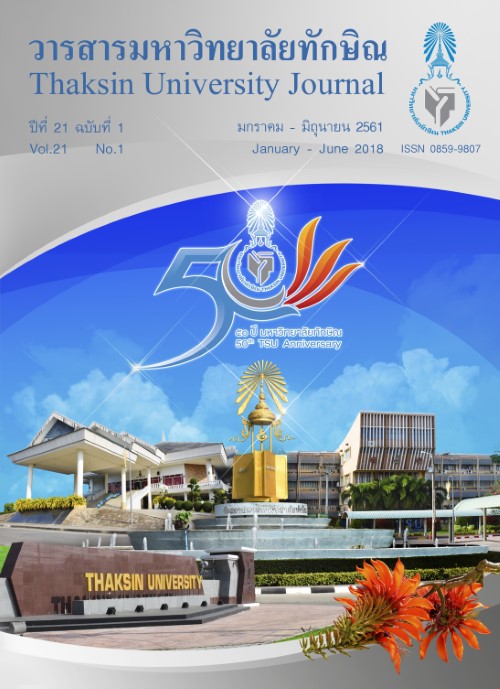The Restoration of Fresh Water Fish in the Papayom Canal by Community Participation
Main Article Content
Abstract
The objective of this research was to develop methods of increasing the abundance of fish in the Papayom canal. Three kinds of fish habitats made from coconut, shakhotaka and bamboo branches were placed in three study sites, namely Ban Pab, Ban Taton and Ban Wangrae. One thousand marked yellow mystus (Hemibagrus nemurus) and 5,000 herbivorous fish fingerlings were stocked in each study site by community participation. The results showed that seven species of fish belonged to 4 families were founded at the beginning of the study whereas a total of fifteen species of fish belonged to 10 families were found at the artificial habitat site and at the end of the study. Besides, mature yellow were also found at the study sites. The result from this study indicated that the management of a water ecosystem by constructing fish habitats combined with fish restocking (small herbivore and carnivore fish) resulted in an increasing number species of fish in the Papayom canal. The information from this study can be used as a guideline for fish conservation and restoration in small rivers so that the sustainable use of natural resources can be maintained.
Article Details

This work is licensed under a Creative Commons Attribution-NonCommercial-NoDerivatives 4.0 International License.
References
Prieur-Richard, A. H., Soto, D., Stiassny, M. L. J. and Sullivan, C. A. (2006). “Freshwater Biodiversity:
Importance, Threats, Status and Conservation Challenges”, Biological Reviews. 81, 163–182.
[2] Arlinghaus, R., Lorenzen, K., Johnson, B.M., Cooke, S.J. and Cowx, I. G. (2016). “Management of Freshwater
Fisheries: Addressing Habitat, People and Fishes In: Craig, J.F. (ed)”, Freshwater Fisheries Ecology.
557-579. Chichester: John Wiley & Sons, Ltd.
[3] Welcomme, R. L. (2001). Inland Fisheries Ecology and Management. Oxford: Fishing News Books, Blackwell
Science.
[4] Lorenzen, K., Beveridge, M. C. M. and Mangel, M. (2012). “Cultured Fish: Integrative Biology and Management
of Domestication and Interactions with Wild Fish”, Biological Reviews. 87, 639–660.
[5] Lorenzen, K. (2008). “Understanding and Managing Enhancement Fisheries Systems”, Reviews in Fisheries
Science. 16, 10–23.
[6] Nelson, J. S. (2006). Fishes of the World. 4th ed. New York: John Wiley & Sons.
[7] Hasler, C. T., Mossop, B., Patterson, D. A., Hinch, S. G. and Cooke, S. J. (2012). “Swimming Activity of
Migrating Chinook Salmon in a Regulated River”, Aquatic Biology. 17, 47–56.
[8] William, F., Beamish, H., Sa-ardrit, P. and Tongnunui, S. (2006). “Habitat Characteristics of the Cyprinidae
in Small Rivers in Central Thailand”, Environmental Biology of Fishes. 76, 237–253.
[9] Dang, N.B., Momtaz, S. Zimmerman, K. and Nhung, P.T.H. (2015). “The Contributions of Fisher’s
Knowledge to Marine Fisheries Management a Case Study of a Coastal Commune in Vietnam” Asia
Pacific Journal of Advance Business and Social Studies. 1(1), 124-135.
[10] FAO. (2012). Recreational Fisheries. Rome: FAO Technical Guidelines for Responsible Fisheries 13.

